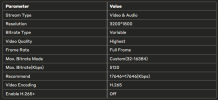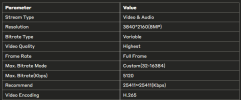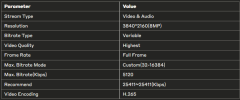Keep in mind those cameras are not on ideal MP/sensor ratios, so they may not perform as well in darker settings.
With H265, most of us don't see the savings that are marketed. Mine was literally a few minutes each day.
H265 in theory provides more storage as it compresses differently, but part of that compression means it macro blocks big areas of the image that it thinks isn't moving. That can be problematic for digital zooming with H265.
However, it also takes more processing power of the already small CPU in the camera and that can be problematic if someone is maxing out the camera in other areas like FPS and then it stutters.
Further some cameras can handle H265 better than others, even if the camera "claims" to support it.
In theory it is supposed to need 30% less storage than H264, but most of us have found it isn't that much. My savings were less than few minutes per day. And to my eye and others that I showed clips to and just said do you like video 1 or video 2 better, everyone thought the H264 provided a better image.
The left image is H264, so all the blocks are the same size corresponding to the resolution of the camera. H265 takes areas that it doesn't think has motion and makes them into bigger blocks and in doing so lessens the resolution in those larger blocks yet increases the camera CPU demand to develop these larger blocks.
In theory H265 is supposed to need half the bitrate because of the macroblocking. But if there is a lot of motion in the image, then it becomes a pixelated mess. The only way to get around that is a higher bitrate. But if you need to run the same bitrate for H265 as you do H264, then the storage savings is essentially zero.
In my testing I have one camera that sees a parked car in front of my house. H265 sees that the car isn't moving, so it macroblocks the whole car and surrounding area. Then the car owner walked up to the car and got in and the motion is missed because of the macroblock being so large. Or if it catches it, because the bitrate is low, it is a pixelated mess during the critical capture point and by the time H265 adjusts to there is now motion, the ideal capture is missed.
In my case, the car is clear and defined in H264, but is blurry and soft edges in H265.
Digital zooming is never really good and not something we recommend, but you stand a better chance of some digital zoom with H264 rather than a large macroblocked H265. I can digital zoom on my overview camera and kinda make out the address number of the house across the street with H264, but not a chance with H265 as it macroblocked his whole house.
H265 is one of those theory things that sounds good, but reality use is much different.
Some people have a field of view or goals that allow H265 to be sufficient for their needs.
As always, YMMV.








